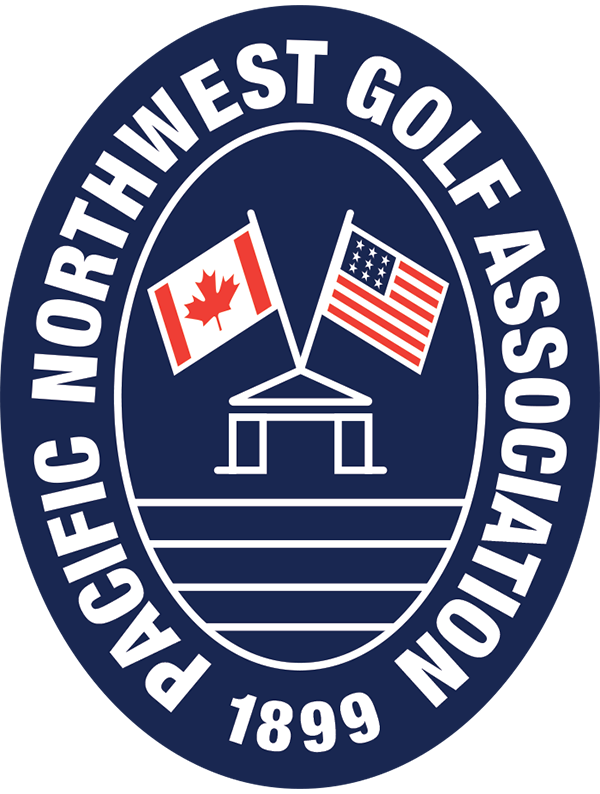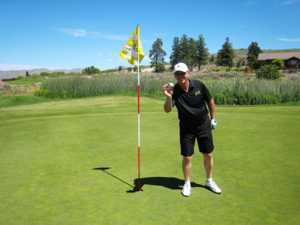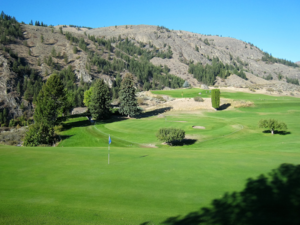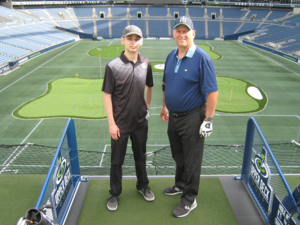Playing for Keeps
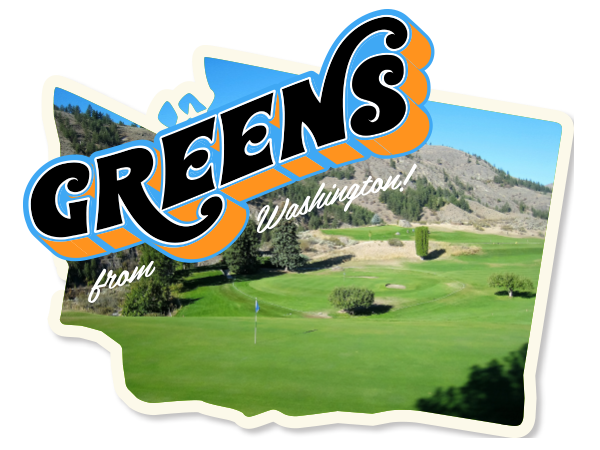 Paul Huber set out to play every public course in Washington, and used his own criteria for what makes an enjoyable golf experience. With his son Nick joining him, it was a journey to find what matters
Paul Huber set out to play every public course in Washington, and used his own criteria for what makes an enjoyable golf experience. With his son Nick joining him, it was a journey to find what matters
Paul Huber calls it “The Journey,” his four-year quest to play every publicly available golf course in Washington.
He doesn’t claim any big need to pass judgment – it’s more just chasing a passion. But judge he did: He played, and ranked, 230 public courses in the state.
The Journey, subtitled “Playing from the Whites,” began at the par-3 course at Riverbend in Kent in April 2013. It ended in August 2017, 360 degrees later, at the full-length 18 at Riverbend.
“I learned a lot about how to play the game, how to enjoy the game and which courses are better, which courses are not,” he says. “I just had a great time doing it.”
It was during recovery from August 2012 rotator-cuff surgery that Huber, 55, a Boeing engineering manager who lives in Maple Valley, Wash. created the pin map of Washington courses he aimed to play.
Once launched on his journey, he documented every step, thoroughly, painstakingly. Every course, every hole, every swing. For the record: He took 15,363 golf shots, making two eagles, 152 birdies and 1,525 pars.
His son Nick Huber, now 22, played with him at a hundred or so of the courses on the journey. Each man secured a hole in one – Nick on No. 4 at Cedars on Salmon Creek, Paul on No. 4 at Desert Canyon.
His Canon Sure Shot got a workout: He photographed every one of the 2,988 golf holes he played, and he has shots of himself (and often Nick) in front of the main golf course sign at every course.
Huber had seen the lists in magazines that annually rank the Top 10 courses in the state. His list is different. By journey’s end, he had opinions – at least 230 of them – based less on “shot values” or “resistance to scoring” than his own deeply held convictions.
First among them: Golf should be fun.
As a single-digit handicapper, Huber is good enough to play from the back tees at most golf courses. But he played from the white tees at every course on The Journey because it was more fun for him and lots more fun for Nick, a 30 handicap, or for any playing partner with a 20-something index who would struggle to pull off all the shots demanded from the blacks.
That’s not fun, he says.
Huber found hidden gems tucked away in places like Oroville and Quincy and Hoodsport. He found frustration at some prestigious, high-dollar courses that annually land at or near the top of Washington Top 10s.
He found joy where he found it.
He grouped his rankings in three categories – par-3 courses, 9-hole courses and 18-hole courses – and listed them in columns headed by Top, Above Average, Middle of the Road, “Why Did I Stop Here?” and Bottom of the Barrel.
The course that teed up his trek – the par-3 at Riverbend (which sadly has since closed) – ranked high (No. 3) among its short-course brethren on a list topped by Sunserra at Crescent Bar Resort. Sunserra, in Quincy, Wash., was a surprise to encounter, Huber says.
Lake Cushman Golf Course in Hoodsport earned Huber’s No. 1 nod among 9-hole venues, just above Tapps Island in Lake Tapps.
“I just found (Cushman) as a hidden gem,” he says. “It was beautiful out there when I played it. The course conditions were really well done. The greens were all fair, all appropriately placed. You weren’t wondering what the hidden trick was to the next shot.”
Huber gave the top rung among 18-hole courses to Yakima’s Apple Tree, no stranger to “best of” charts but better known for its Apple Island Green on the par-3 17th.
The Huber Top 10 for 18s is notable for who didn’t crack it. Some of the state’s known courses didn’t make his list.
There are reasons, good Huber reasons, why these and other esteemed courses fell down his lists. High green fees or punitive landscapes dampen the fun for the average golfer in some places, he says.
If you make it difficult to get on your course and aren’t even nice about it, he doesn’t need you.
And then there are all those blind shots. He hates blind shots.
“Blind shots I just find absolutely frustrating,” he says. “They hurt golfers in many ways. You might want to make the round, the experience, something enjoyable rather than as hard as you can make it.”
His lists, idiosyncratic as they might be, are shaped out of individual snapshots of a day and a round at a golf course and the land it sits on, the road trip to get there, and the way the shots fell, that day.
“I can guess 99 percent of Westsiders have never been north of Spokane,” he says. “When you get up there, 15 miles north, the trees and the hills and the mountains, it is gorgeous. You’re driving along the Pend Oreille River as you’re going north, winding your way through the hills. I would never have done that if I hadn’t had to go play a golf course.”
There were days he didn’t play well, he says, because a course “didn’t match my eye” or play to his natural draw shot shape.
“Is that something I penalize the golf course for?” he said, laughing. “Well, possibly.”
Since The Journey ended, Huber has racked up another rotator-cuff surgery (on the other shoulder) and logged 47 entries in the book for his next ramble through Washington golf – his mission to play the 62 private courses in the state.
If you want to land high on his list, maybe go easy on the blind shots.
